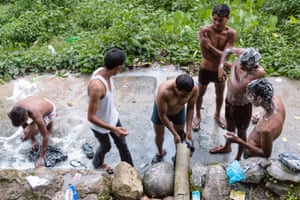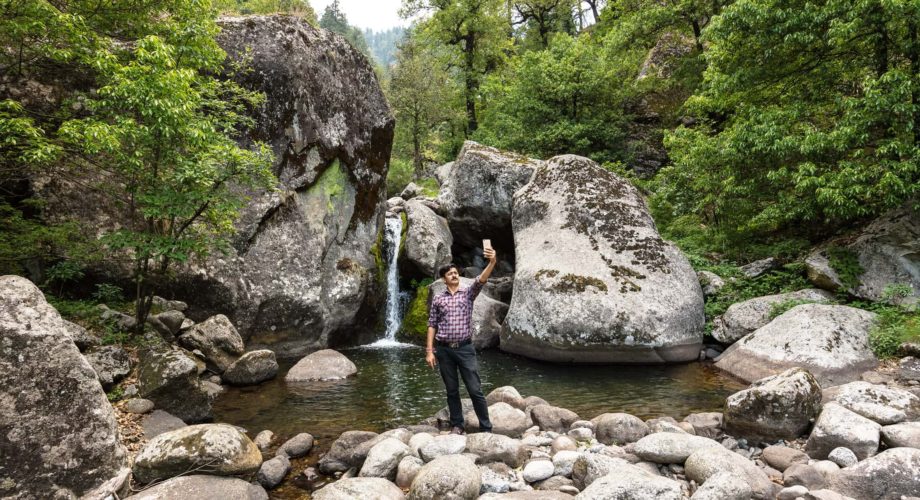
In the small towns and villages of the Himalayas across India and Nepal, communities depend on surface water from glacier-fed rivers, springs, ponds and lakes for domestic use and for agriculture.
Yet this is a region at the forefront of global climate change. Glaciers are shrinking quickly, particularly in the eastern and central Himalayas, which is likely to significantly reduce flows of water downstream. Intensive land uses such as logging and stone quarrying, combined with urbanisation and a rise in tourism, are all putting immense pressure on the region’s water supply.
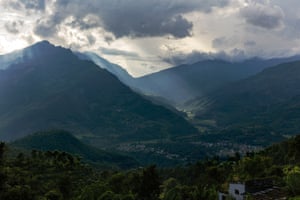
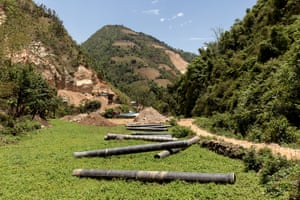
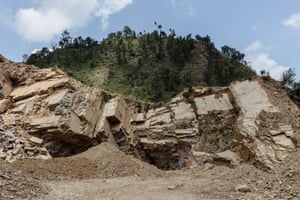
- Left, steel pipelines lie stockpiled in a farmer’s field, in Kushadevi, Nepal, with a stone quarry visible behind it; right, a quarry near Dhulikhel
In Dhulikhel, water demands are increasing as the town expands. A 14km pipeline now brings water into the Nepalese community, but the laying of new pipes has been disruptive for the settlements and farms through which they pass, triggering protests.
The upstream communities have their own changing needs as patterns of agriculture shift away from cereals towards more water-demanding cash crops, such as fruit and vegetables.
Stone quarrying is leaving visible scars on the landscape, as well as seriously threatening water quality in these rural areas.
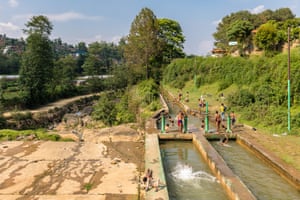
Young boys escape the summer heat by playing in a canal downstream from a small dam, in Panauti, Nepal. Designed to direct water into a small hydroelectric scheme, the system flouts environmental regulations by leaving almost zero flow in the stream bed.
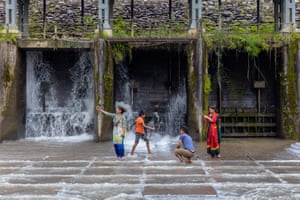
Water is revered in India and Nepal, and moving water, especially rivers, are considered sacred, life-affirming and purifying. Here, a family plays precariously in the spillway of a hydroelectric dam in the Nepalese town of Bidur. The canal above the dam provides both electricity and water for the town.
Mussoorie

Over the past century, tourism has driven urbanisation and growth in the mountains. In recent years the domestic markets have picked up apace, as the growing Indian and Nepalese middle classes escape the heat of the plains during the school holidays and festive seasons.
Mussoorie in Uttarakhand, India, is a thriving example of the former colonial hill station towns so popular with local tourists. Old photographs reveal how the area has changed.
- Archive photos: Unknown/Courtesy of Centre for South Asian Studies; Lilian Rust/Courtesy of Centre for South Asian Studies
The influx of visitors places the town’s resources and infrastructures under significant strain, with government departments and agencies unable to check unauthorised building activity and urban sprawl.
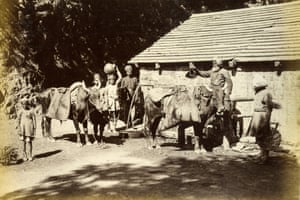

- Left, water carriers in Mussoorie around 1880; right, a motorbike mechanic in the town’s Landour Bazaar
Over the past decade, Mussoorie grown at a rate of more than 15%. It sources its water from more than 20 separate springs, but high season demand far outstrips supply. The government is considering alternatives, which include a scheme to supply water pumped up the mountain via a multi-stage lift from the Yamuna river. Others suggest that improved capture and storage of precipitation in the Mussoorie ridge and a revival of the springs and other surface water sources might be a cheaper and more sustainable option.
Nainital

Nainital is another popular Uttarakhand hill town that has grown at pace since the 19th century. Its history is a reminder of how precarious life in the mountains can be, particularly as construction on steep slopes is usually at the expense of trees that hold the hillside together by preventing erosion. In 1880, the built-up northern ridge around Lake Naini collapsed after heavy rain, killing more than 150 people. As urban pressures have increased, the vulnerable hillside has gradually been built up for residential and tourist housing.
- Archive photo by Samuel Bourne/Courtesy of Cambridge University Library
The risk of landslides in the Himalayas remains high, especially during the monsoon months, with many of the town’s poorest residents building homes on the most eroded and unstable slopes.
Water shortages and scarcity are typically at their peak in the pre-monsoon summer season, and many springs slow to a trickle or disappear. Local families have to rely on bottled water as well as making use of alternative sources further away. Hotels pay 10,000-litre tankers to deliver supplies to their doors, so that guests can access running water through the day.
- Archive photo by Samuel Bourne/Courtesy of Cambridge University Library
During the summer months, the floating population of tourists and seasonal workers can add up to double the number of permanent residents, putting huge pressure on the towns’ resources.
Unregulated hotels and guesthouses bring with them waste and sewerage problems, with the benefits and opportunities of tourism afforded only to the few.
In Mussoorie, local teacher Rabeen Vasudev complains that local government only considers the profits of getting the maximum number of visitors. “They do not take the time to consider the side effects, such as trash and damage to our environment.”
The lure of tourism can be disruptive in other ways. Jaipal Rana, from Mussoorie, says: “I have met many young boys who flunk school at eight years old. Why would they persist in education or take the tough life of farming when they think that owning a taxi or chai shop can bring fast cash?”
Nainital town and its growing economy depend on the health of its beautiful lake. Yet levels are declining, thanks to a combination of factors, including reduced rainfall, the concreting of porous areas that previously filtered water into the basin and the town’s growing water demands.
Seasonal water shortages are a problem across the Himalayas, as peak scarcity coincides with the period of highest demand, in the dry summer months. For the second year in a row, Nainital’s water levels declined to record low levels last summer, revealing its significant waste and pollution problems.


In the last five years the picturesque Kempty Falls, 13km from Mussoorie, have seen an explosion in domestic tourists, development and unregulated construction – fuelled by sustained promotion of the destination by Uttarakhand state tourism department.
The surrounding villages are growing at an unsustainable rate, with incomers keen to capitalise on the Falls’ popularity. Domestic construction has stretched water supplies and sanitation past breaking point.
In the peak summer months, four-hour traffic jams clog the narrow road from Kempty to Mussoorie.
More alarming is the rash of poorly constructed hotels, restaurants and gift shops jostling for tourist trade along Kempty road. The precipitous terrain has meant that they are stacked precariously on skinny concrete stilts or carved into the hillside.
In an area prone to seismic shift, extreme rainfall and landslip events – this could be a disaster in the making.
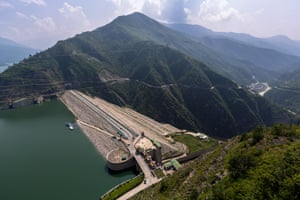
- The Tehri Dam, on the Bhagirathi river, in Uttarakhand. It is the highest such construction in India
Governments and donor programmes have responded to the growing demands on water supply by building pumping stations, dams and hydropower projects, designed to move vast amounts of water across greater distances. These interventions are high in capital investment and energy intensive, and result in enormous changes to the landscapes and livelihoods around them.
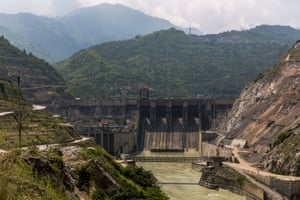
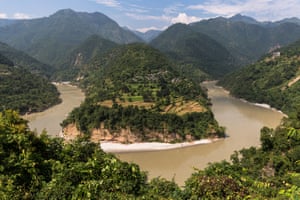
- Left: Dams on the Bhagirathi river, Uttarakhand. Right: The dam reduces the river’s speed, which means that sand is deposited on the inside track of river bends
Recent state investments that have brought pipelines and taps directly into homes are rapidly changing the aspirations of families, as many can see the convenience of piped water being available directly in their homes. But such water is generally evaluated as being of poor quality, particularly during the monsoon, and is only available for a couple of hours a day. This uncertainty means that families still depend significantly on their local springs.
Poorer households are less likely to be able to afford the costs associated with formal connection charges, pipes and meters, and depend entirely on springs.
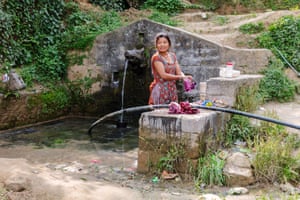
The Dhobighat community downstream of Mussoorie provides laundering services to the upstream town’s schools, hotels and government institutions. Washing is done along a natural stream that flows through the settlement, first inhabited by the dhobi (washing) community more than 80 years ago. Their livelihood depends on clean, fast-running water. In recent times, they have been asked by local government to “share” their stream with other nearby settlements, meaning there is less to go round. With young people leaving to seek work elsewhere and the advent of mechanised washing machines, the demand for washing services is declining, so these livelihoods look increasingly vulnerable.
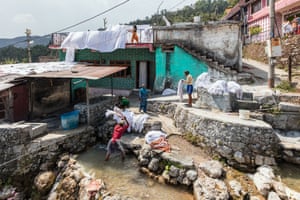
Creating and running water management systems that do not adversely impact the poorest people in Himalayan society is vitally important.


- Voting in Dulikhel’s local council elections
During May 2017, Nepal held its first local council elections in almost 20 years. At Dhulikhel, water provision to all areas of the town is a highly political topic, with candidates campaigning and competing on this issue to secure the votes of their constituents. Water politics did influence the outcome – a new mayor was elected who is committed to locally sourcing affordable water for town residents.
This research was partly funded with support from the Ecosystem Services for Poverty Alleviation (ESPA) programme. Further details and analysis can be found on the project website, www.panipahar.com
